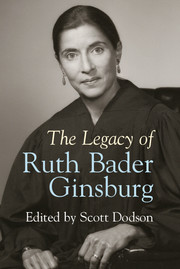Book contents
- Frontmatter
- Contents
- Contributors
- Preface
- Acknowledgments
- Part I Shaping a Legacy
- 1 Notes on a Life
- 2 Ruth Bader Ginsburg
- 3 Before Frontiero There Was Reed
- 4 Struck by Stereotype
- A Postscript to Struck by Stereotype
- 5 Beyond the Tough Guise
- Part II Rights and Remedies
- Part III Structuralism
- Part IV The Jurist
- Notes
- Index
5 - Beyond the Tough Guise
Justice Ginsburg’s Reconstructive Feminism
Published online by Cambridge University Press: 05 February 2015
- Frontmatter
- Contents
- Contributors
- Preface
- Acknowledgments
- Part I Shaping a Legacy
- 1 Notes on a Life
- 2 Ruth Bader Ginsburg
- 3 Before Frontiero There Was Reed
- 4 Struck by Stereotype
- A Postscript to Struck by Stereotype
- 5 Beyond the Tough Guise
- Part II Rights and Remedies
- Part III Structuralism
- Part IV The Jurist
- Notes
- Index
Summary
For someone who has been called the Thurgood Marshall of women, Justice Ginsburg has received remarkably little attention from legal feminists. Indeed, for decades, she has been consigned to the dustbin of Formal Equality, as someone obsessed with treating men and women the same under the law, to women’s detriment, even when the two groups were clearly different.
Those wishing to salvage Ginsburg’s reputation recently have defended her as an “antisubordination” feminist, applying to Ginsburg a term invented by legal theorist Catharine MacKinnon to describe her own approach. In this essay, I argue that associating Ginsburg with MacKinnon’s “feminism unmodified” ultimately proves confusing because it glosses over important differences between the two women. Ginsburg is more fruitfully seen as a reconstructive feminist whose goal is to reconstruct breadwinner and caregiver roles and, more generally, the relationship of market work and family work. This chapter ends by taking reconstructive feminism the next step: it proposes to jumpstart the stalled gender revolution by placing masculinity’s “tough guise” at the center of feminist analysis.
Is Ginsburg an Antisubordination Theorist?
Pointing to her brief in Struck v. Secretary of Defense, Neil Siegel and Reva Siegel argue that Justice Ginsburg should be seen through an antisubordination lens. The Struck brief’s antisubordination rhetoric is not an aberration. In fact, the briefs from the landmark 1970s cases Ginsburg was involved with under the auspices of the ACLU Women’s Rights Project are chockfull of antisubordination rhetoric.
- Type
- Chapter
- Information
- The Legacy of Ruth Bader Ginsburg , pp. 59 - 70Publisher: Cambridge University PressPrint publication year: 2015

